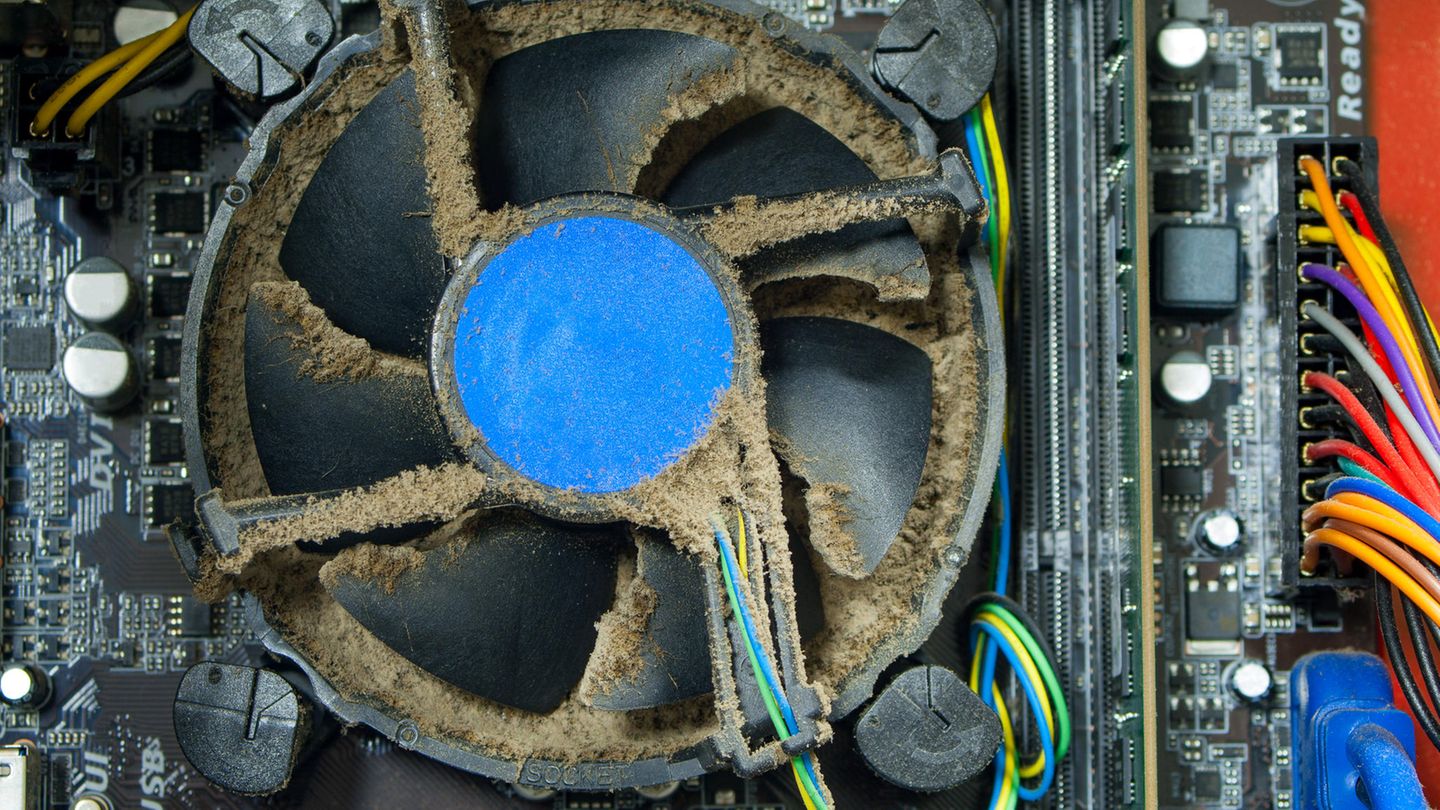Air compressors blow dust from the most remote corners when cleaning PCs. Whoever blows too brutally into the computer is putting his hardware at risk. These tips will keep your PC clean and safe.
When the computer overheats, it is usually because its fans and cooling fins are clogged with dust. Depending on the household, this can be the case after eight to twelve months after commissioning – even faster for pet owners. PC fans are a magical attraction for your best friends’ hair.
The only thing that helps here is to thoroughly clean the PC, preferably with compressed air. You don’t want to use a vacuum cleaner: its attachments are usually too big to get into the small nooks and crannies of a desktop computer, and because of its suction power, it is only too happy to inhale small parts such as condensers that are actually firmly soldered. The total loss is imminent.
It is better to blow dust out of the computer and vacuum it up afterwards if necessary. This is made possible by handy air compressors or compressed air bottles. However, caution is required with large air compressors: If they are set too high, you can destroy the hardware because the pressure blows the capacitors away.
Clean PC with air compressor
If you want to be on the safe side, you can use an air pressure compressor that was specially developed for computers. A formidable device is that . Its attachments and brush heads set it apart from the competition. They are designed to get into the most remote corners of the computer and also to remove dust from peripheral devices such as keyboards. Two performance levels determine how hard the computer cleaner blows. The only downer: the device is wired.
It is a bit smaller and more manageable . The manufacturer relies on a rechargeable battery that you can charge using the supplied mini USB cable. In addition to the normal head, the dust blower comes with a brush head. Nice: Both variants are movable so that you can get into the corners more easily when cleaning.
If you don’t just want to clean your PC, you can get a small one too Make sense. You can also use it to effortlessly inflate bicycle tires or air mattresses. However, comfort functions such as various brush heads are missing.
Alternatively, take it . Compared to compressors, however, the “air” is quite expensive, which is why the investment in an air compressor pays off after a few cleanings.
Another tool in the overview
Without the right tools, no work is really fun – but with a proper device, even cleaning a dirty computer is satisfactory. An air compressor alone is rarely enough to clean the computer thoroughly. An overview:
1. Anti-Statik-Band
A is not absolutely necessary. You can also discharge yourself on earthed objects. However, with the bracelet you are a little less stressful and worry-free on the go.
2. Rubbing alcohol
Electronic devices and water never get along well if the components are still connected to the electricity. But even if all parts are unloaded, it is advisable to start earlier than relying on water. It evaporates faster and there is less risk of an accident.
3. Microfiber cloths
You should not use kitchen paper for cleaning. This means that there is a risk that the paper towels will get stuck on small corners and edges and leave residues that are difficult to remove. More robust ones are better . However, you shouldn’t use them too brutally either.
4. Clean PC with air compressor: toothbrush
With an unused toothbrush, remove the very coarse dirt at the beginning. And not only that: If it is made of plastic, the toothbrush is ideal for holding remote fans in place. You should always do this with non-conductive objects.
5. Fine tuning with a fine brush
After the PC has been cleaned with compressed air, there is usually a thin layer of dust on individual components. You will with one Come on. Make sure, however, that the brush is made of real hair. Synthetic hair can become statically charged and damage the hardware.
This is how you go about cleaning
- Lock the calculator
- Press the power switch for about ten seconds to get rid of the residual current
- Discharge or put on anti-static wrist strap
- Remove the side and front doors and clean them separately
- Remove the dust filter and clean it separately
- Get to work in the computer – hold the fan while blowing through! Do not use any metallic objects for this
- Remove stubborn dust with a brush
- Check the PC for small parts that have fallen off
Further tips: It is better to clean outside the door
Depending on the degree of soiling of the hardware, it can make sense to clean the door in front of the door, otherwise you will spread huge amounts of dust in your apartment. There should be a power connection for the air compressor and a workbench in front of the door or in the garage. Stone floors cause nasty scratches on the case.
Computer and yourself discharge
Before you start, you should press the power switch on the computer again for about ten seconds so that any residual current in the components disappears. Then the switch of the power supply unit can still be set to “Off”. Before the real work begins, you too need to discharge yourself either by wearing an anti-static wrist strap or by touching an earthed object such as a heater.
Remove removable components
The actual procedure is simple: First, remove all components of the housing, i.e. both side doors and, if necessary, the front door and any dust filters. It is advisable to have several small bowls ready for the screws so that they do not get lost. You clean all components that do not have electronics on them separately.
If you have enough time, you can use a damp cloth on non-electronic devices such as side doors. Alternatively, you can use rubbing alcohol, which evaporates faster. It is best to first blow the fine grids of the dust filters free with compressed air and then clean them with a small damp brush. Before you screw the parts back onto the PC, they must of course be dry.
Blow from the inside out
Cleaning the inside is a bit trickier if you don’t want to remove the various components. First of all, you should hand-remove any dirt that you can remove by hand. If that’s too unsavory for you, you can use an unused and dry toothbrush. If you work with compressed air straight away, you run the risk of blowing coarse lumps of dust into corners where you don’t want dust.
Once the worst has been eliminated, the compressed air is used. There is one basic rule to keep in mind: The PC fans must be held in place before you can use the air to remove the dust. With the exception of the power supply fan, you can use your fingers for this. Under no circumstances should you do anything with your fingers in the power supply unit. Here the residual voltage can give you life-threatening electric shocks.
And some case fans are so inconvenient that they cannot be reached with your fingers. Here you should use a long, non-conductive object to hold the fan blade in place. The toothbrush mentioned at the beginning is ideal for this.
Logical: Always blow out of the housing if possible. Otherwise you will just spread the dirt further and it won’t take long for the fans to pull it back on and get dirty. Caution is also required with the cooling fins of the CPU and graphics card. If possible, be careful not to blow dust into the fine openings. After blowing out, there is usually a thin layer left on SSD storage etc. You can do this with a fine brush. If the PC is clean, you should check the interior again for small parts that have fallen off.
David William is a talented author who has made a name for himself in the world of writing. He is a professional author who writes on a wide range of topics, from general interest to opinion news. David is currently working as a writer at 24 hours worlds where he brings his unique perspective and in-depth research to his articles, making them both informative and engaging.




